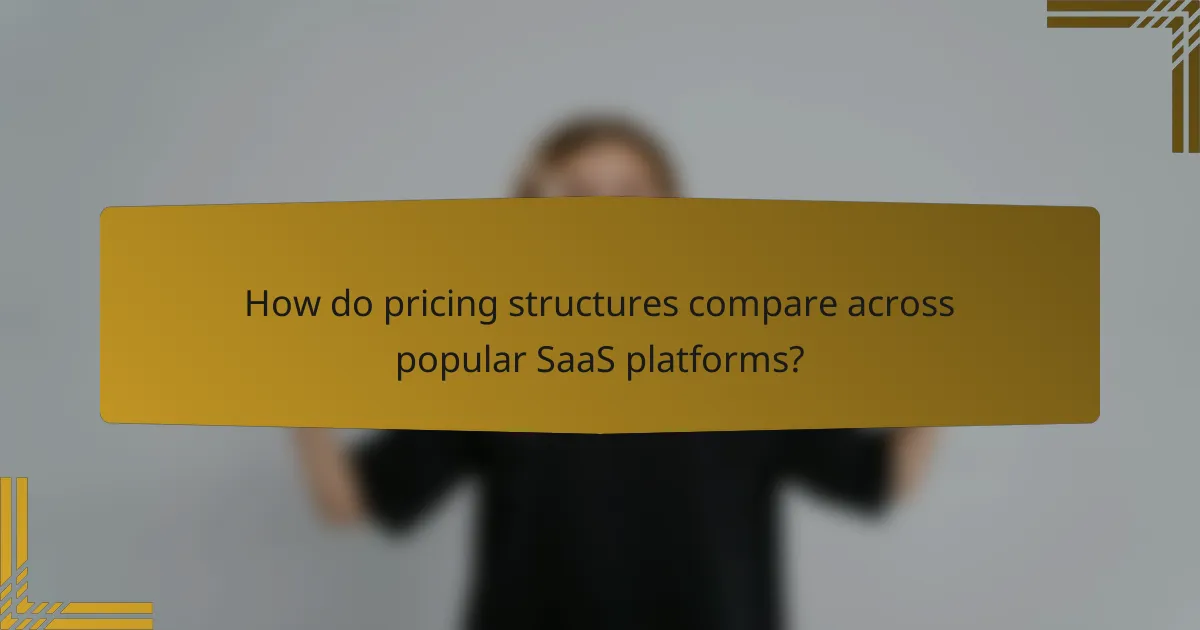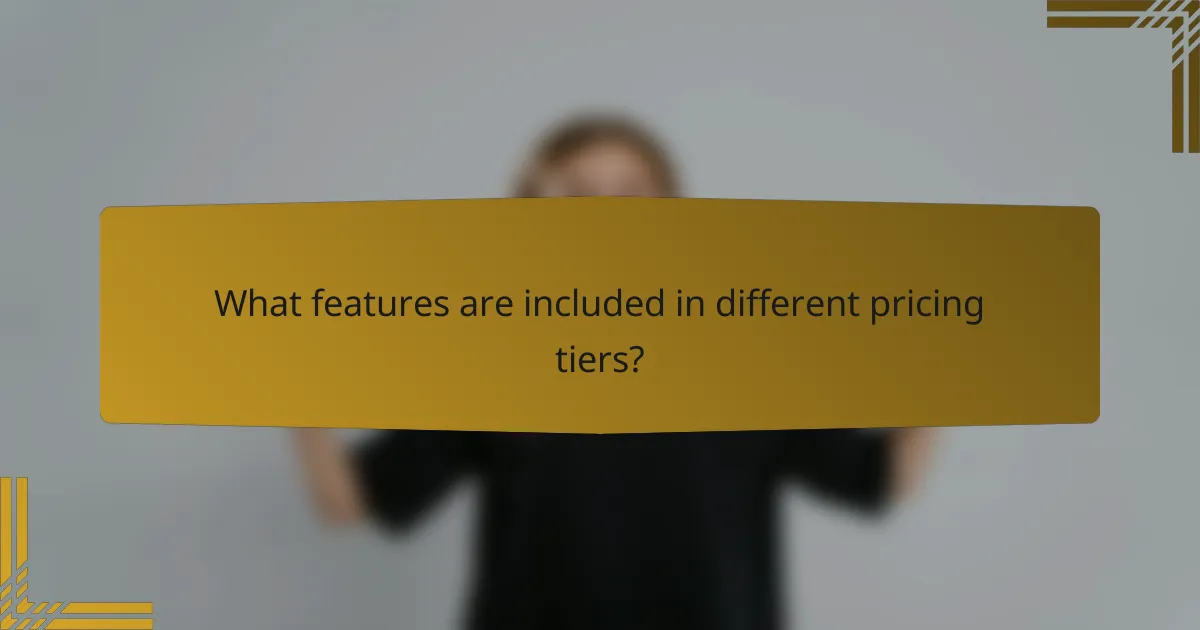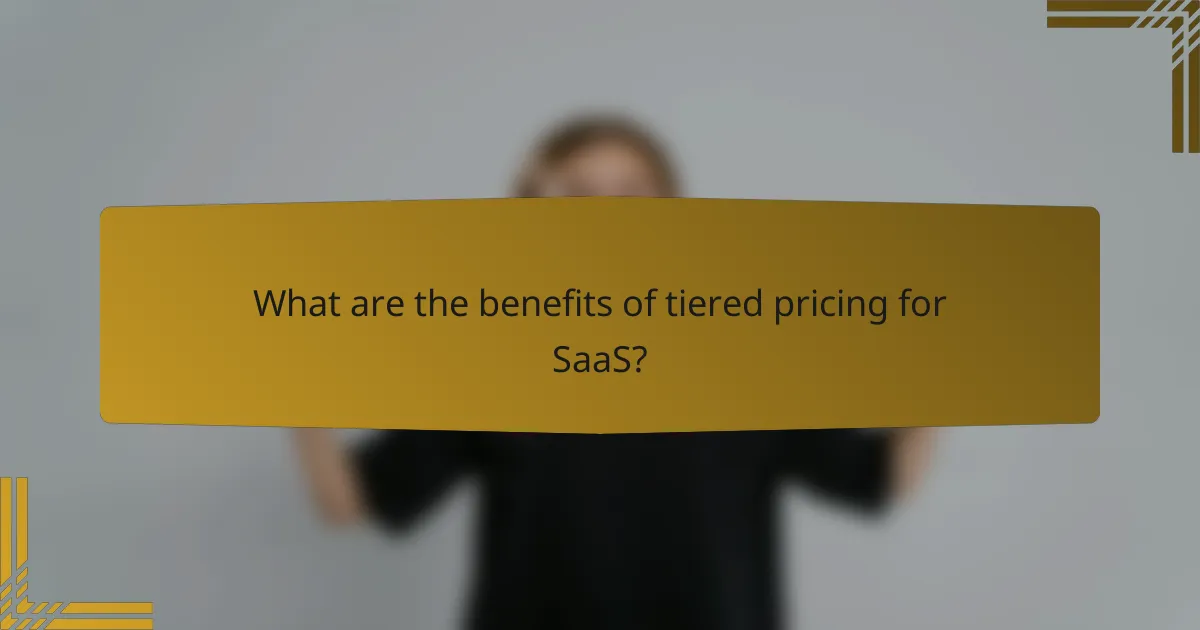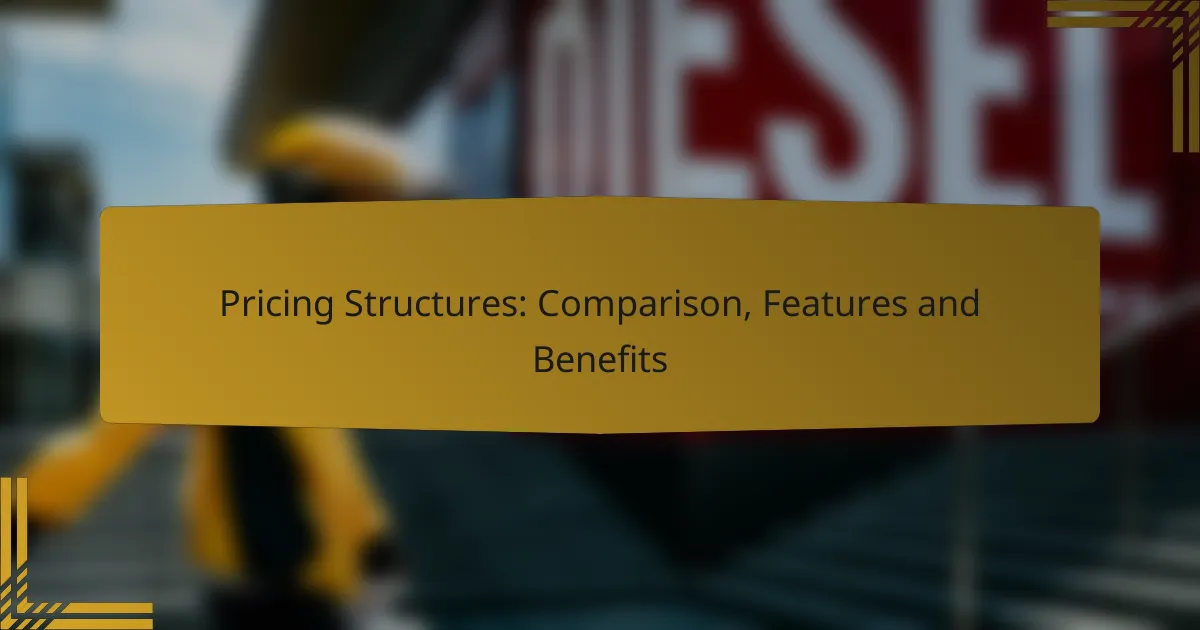In the competitive landscape of SaaS tools, pricing structures play a crucial role in meeting diverse customer needs and optimizing costs. By comparing various pricing models, businesses can identify the best software solutions that align with their budget and feature requirements, ensuring they select the most suitable platform for their operations.

What are the pricing structures for SaaS tools?
SaaS tools typically utilize various pricing structures to cater to different customer needs and usage patterns. Understanding these pricing models can help businesses choose the right software while managing costs effectively.
Subscription-based pricing
Subscription-based pricing is a common model where users pay a recurring fee, usually monthly or annually, for access to the software. This model often includes different plans that offer varying features and levels of service.
For example, a basic plan may start at around $10 per month, while premium plans can exceed $100 monthly, depending on the features included. This structure provides predictable costs and continuous access to updates and support.
Freemium model
The freemium model allows users to access a basic version of the software for free, with the option to upgrade to a paid version for additional features. This approach is effective for attracting a large user base.
Many companies use this model to convert free users into paying customers by offering advanced functionalities, such as enhanced storage or premium support, typically priced between $5 and $50 per month.
Pay-as-you-go pricing
Pay-as-you-go pricing charges users based on their actual usage of the software, making it a flexible option for businesses with fluctuating needs. This model is often seen in cloud services where users pay for the resources they consume.
For instance, a company might pay $0.10 per transaction or $0.01 per GB of data processed. This structure can be cost-effective for businesses that do not require constant access to the software.
Tiered pricing plans
Tiered pricing plans offer multiple packages with different features and price points, allowing customers to choose a plan that best fits their needs. Each tier typically includes a set of features that increase in value as the price rises.
For example, a basic tier might cost $20 per month with limited features, while a higher tier could be priced at $100 per month with advanced analytics and integrations. This model helps businesses scale their usage as they grow.
Enterprise pricing options
Enterprise pricing options are tailored for large organizations with specific needs and often involve custom quotes based on the scale of usage and required features. This model typically includes dedicated support and additional services.
Enterprise plans can range significantly in cost, often starting in the low hundreds and going into thousands of dollars per month, depending on the complexity of the solution and the number of users involved. Engaging directly with the provider is essential to negotiate terms that suit the enterprise’s requirements.

How do pricing structures compare across popular SaaS platforms?
Pricing structures for popular SaaS platforms vary significantly based on features, user tiers, and billing cycles. Understanding these differences can help businesses choose the right platform that aligns with their budget and needs.
Salesforce pricing comparison
Salesforce offers a tiered pricing model with several editions, including Essentials, Professional, Enterprise, and Unlimited. Prices typically range from around $25 to $300 per user per month, depending on the features included. Businesses should consider their specific requirements, as higher tiers provide advanced functionalities like custom app development and enhanced analytics.
When evaluating Salesforce, it’s crucial to factor in potential additional costs for add-ons and integrations, which can increase the overall expenditure. Companies often benefit from starting with a lower tier and upgrading as their needs grow.
HubSpot pricing overview
HubSpot’s pricing structure is segmented into free, Starter, Professional, and Enterprise tiers. The Starter plan begins at approximately $50 per month, while the Enterprise tier can exceed $3,200 monthly, depending on the number of contacts and features. HubSpot is particularly attractive for small to medium-sized businesses due to its free tools and scalable options.
It’s essential to assess which features are necessary for your business, as many advanced capabilities are locked behind higher tiers. HubSpot also offers add-ons that can enhance functionality but may increase costs significantly.
Zoom pricing tiers
Zoom provides a straightforward pricing model with free and paid plans, including Pro, Business, and Enterprise options. The Pro plan starts at around $149.90 per year per user, while the Business plan is approximately $199.90 per year per user. Each tier adds features such as increased participant limits and cloud recording capabilities.
Businesses should evaluate their typical meeting size and required features when selecting a plan. The free version is suitable for basic needs, but organizations with larger teams or advanced requirements may find value in the paid tiers.
Slack pricing analysis
Slack’s pricing includes a free version, along with Standard, Plus, and Enterprise Grid plans. The Standard plan starts at about $6.67 per user per month, while the Plus plan is around $12.50 per user per month. The free version is limited in message history and integrations, making it less suitable for larger teams.
When choosing a Slack plan, consider the number of users and the need for advanced features like compliance exports or enhanced security. Many teams find that the Standard plan meets their needs without unnecessary costs, while larger organizations may benefit from the Enterprise Grid for added control and customization.

What features are included in different pricing tiers?
Different pricing tiers typically offer a range of features that cater to varying user needs. Free plans often include basic functionalities, while premium plans provide advanced tools and integrations that enhance user experience and capabilities.
Basic features in free plans
Free plans generally include essential features such as limited access to core functionalities, basic reporting tools, and community support. Users can often perform fundamental tasks without incurring costs, making these plans suitable for individuals or small teams just starting out.
For example, a free plan might allow users to create a limited number of projects or access basic templates. However, these plans usually come with restrictions on storage space and user collaboration, which can hinder scalability.
Advanced features in premium plans
Premium plans typically offer a suite of advanced features designed for more complex needs. These may include enhanced analytics, automation tools, and customizable workflows that allow for greater efficiency and productivity.
For instance, a premium subscription might provide unlimited project creation, advanced integrations with third-party applications, and priority customer support. These features are particularly beneficial for larger organizations that require robust solutions to manage their operations effectively.
Integration capabilities by tier
Integration capabilities often vary significantly between pricing tiers. Free plans may support only a few basic integrations, while premium plans usually offer extensive options for connecting with other software and services.
For example, a free tier might allow integration with one or two popular tools, whereas a premium tier could support multiple integrations, including CRM systems, payment processors, and marketing platforms. This flexibility can greatly enhance workflow efficiency and data synchronization.
Support options across pricing levels
Support options are another critical aspect that differs by pricing tier. Free plans often provide limited support, such as access to online documentation and community forums, while premium plans typically include dedicated support channels.
Premium users may benefit from features like live chat, priority email support, and even personalized onboarding sessions. This level of support can be crucial for businesses that rely on timely assistance to resolve issues and optimize their use of the service.

What are the benefits of tiered pricing for SaaS?
Tiered pricing for SaaS offers several advantages, including the ability to cater to different user needs and budgets while encouraging customer loyalty. By structuring pricing into multiple tiers, businesses can attract a wider range of customers and provide options that align with varying usage levels and feature requirements.
Flexibility for diverse user needs
Tiered pricing allows SaaS providers to meet the diverse needs of their customer base. Each tier can include different features, usage limits, and support levels, enabling users to select a plan that best fits their specific requirements. For example, a basic tier may offer essential features at a lower cost, while higher tiers provide advanced functionalities for more demanding users.
This flexibility ensures that both small startups and large enterprises can find a suitable plan, making it easier for businesses to scale their usage as they grow. Companies should regularly assess user feedback to refine tier offerings and ensure they remain relevant to customer needs.
Scalability for growing businesses
Tiered pricing supports scalability, allowing businesses to upgrade their plans as they expand. As a company grows, its needs often change, and tiered pricing facilitates this transition without requiring a complete overhaul of the service. For instance, a startup might begin with a basic plan and later upgrade to a more comprehensive tier as their user base increases.
This model not only helps retain customers but also encourages them to invest more in the service over time. SaaS providers should clearly communicate the benefits of upgrading to ensure users understand the value of higher tiers.
Incentives for long-term commitments
Tiered pricing can incentivize customers to commit to longer subscription periods by offering discounts for annual payments compared to monthly billing. This strategy can enhance customer retention and provide predictable revenue streams for the business. For example, a SaaS provider might offer a 10% discount for customers who choose an annual plan over a monthly one.
Additionally, long-term commitments can lead to stronger customer relationships, as users are more likely to engage with the service over an extended period. Businesses should consider implementing loyalty programs or additional perks for long-term subscribers to further enhance retention.

How to choose the right pricing structure for your needs?
Choosing the right pricing structure involves understanding your business model, customer expectations, and financial goals. Consider how different pricing options align with your operational needs and market positioning.
Assessing business requirements
Start by identifying your core business objectives and customer demographics. For instance, subscription models may suit businesses with recurring services, while one-time purchases may be better for retail. Analyze how each pricing structure can support your sales strategy and customer retention efforts.
Consider the complexity of your offerings. If your products or services require extensive customization, a tiered pricing model could provide flexibility. Alternatively, a flat-rate pricing structure might simplify the decision-making process for customers.
Evaluating budget constraints
Your budget will significantly influence your pricing structure choice. Determine how much you can invest in pricing strategies, marketing, and customer acquisition. For example, if your budget is limited, consider a cost-plus pricing model that ensures all expenses are covered while maintaining a profit margin.
Also, assess the potential return on investment (ROI) for each pricing option. A value-based pricing strategy may yield higher profits but requires thorough market research. Ensure that your chosen structure aligns with your financial capabilities and long-term growth plans.
